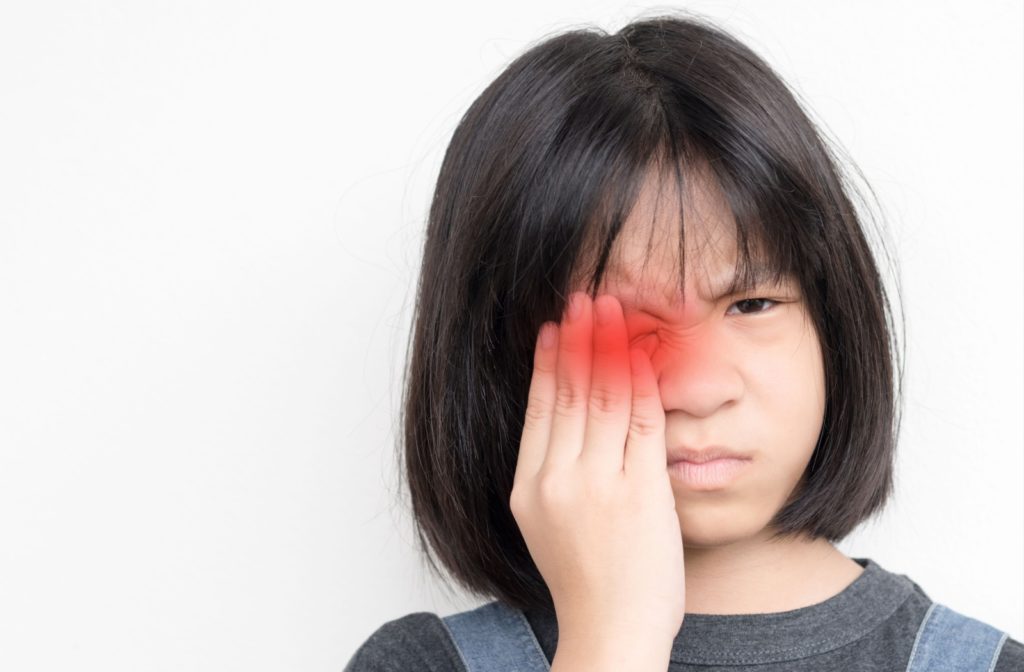As a parent, watching your child battle recurring bouts of pink eye can be both frustrating and concerning, especially when all you want is for them to feel comfortable. Pink eye disrupts your daily routine, adds stress to your family’s life, and causes discomfort for your little one.
Kids often keep getting pink eye due to its contagious nature and its ability to spread quickly through schools and daycares. But you don’t have to simply accept that your child will have to live with recurring symptoms.
By booking a children’s eye exam, you can take proactive steps to prevent pink eye and other eye diseases and help your child enjoy healthy eyes.
What Is Pink Eye?
Pink eye, medically known as conjunctivitis, is an inflammation of the thin clear tissue that lines the inside of the eyelid and covers the white part of the eyeball. There are several types of conjunctivitis, each with distinct causes and treatments. The most common types include:
- Viral Conjunctivitis: Generally caused by the same viruses responsible for the common cold, this type of pink eye is highly contagious and is often accompanied by symptoms such as a runny nose or sore throat.
- Bacterial Conjunctivitis: This contagious form is caused by bacterial infections and can produce significant eye discharge and crusty eyelids.
- Allergic Conjunctivitis: Triggered by allergens such as pollen, dust, or pet dander. While this type of pink eye can cause intense itching and watery eyes, it’s not contagious, so you don’t have to worry about your kid spreading it.
Recognizing pink eye symptoms and getting an idea of what type is affecting your child can help you determine how to respond. In any case, your eye doctor can diagnose and treat pink eye with an eye exam, so timely intervention is one of the best ways to get your kids feeling right again.
Keep an eye out for these common symptoms:
- Redness in the whites of the eyes
- Swelling
- Watery eyes
- Itchy or burning sensation
- Gritty feeling in the eyes
- Clear, yellow, white, or green discharge
- Crust on the eyelashes or eyelids, especially when waking up
- Sensitivity to light
- Blurry vision due to discharge or irritation
How Pink Eye Spreads Among Kids
Pink eye spreads quickly among kids because they often play closely together and, let’s be honest, don’t always practice good hygiene. The contagious types—viral and bacterial conjunctivitis—can easily move through classrooms or daycares. It can spread when a child touches their eyes, then touches others or shares things like towels, toys, or digital devices. Also, sneezes or coughs can spread viral pink eye if kids are too close.
Educating children on personal hygiene and the importance of not sharing certain items can significantly reduce the risk of transmission.

How to Prevent Pink Eye Among Children
Preventing pink eye in kids is all about staying on top of hygiene and being mindful of what they’re exposed to. Here are some friendly tips to keep those little eyes safe:
- Hand hygiene is key: Make sure your kids wash their hands often with soap and water for at least 20 seconds. This is especially important before meals, after using the bathroom, and after playing outside. If you’re out and about, hand sanitizer can be a lifesaver!
- Teach them not to touch: Help your kids understand why they shouldn’t touch or rub their eyes. This is an easy way to keep germs away!
- No sharing, please!: Encourage your kids not to share personal items like towels, washcloths, or bed linens. This also helps keep bacteria and viruses at bay.
- Keep things clean: Regularly wipe down and disinfect common surfaces like doorknobs, toys, and gadgets that your kids often touch and share.
- Manage those allergies: If allergic conjunctivitis is a problem, pinpoint what might be causing it. Keep windows shut during pollen season, consider air purifiers, or use over-the-counter allergy meds if a healthcare pro suggests it.
By following these simple steps, you can help keep your kids’ eyes healthy and create a cleaner, safer environment both at home and wherever they play!
Diagnosing & Treating Pink Eye
Getting diagnosed with pink eye usually means a quick trip to the doctor, who’ll check out your kid’s eyes and chat about their symptoms to figure out the cause. Treatment depends on whether your kid’s pink eye is viral, bacterial, or just allergies, so it‘s important to know the exact cause.
Most viral pink eye cases clear up in around 7–14 days without treatment, while mild bacterial cases can resolve in about 2–5 days. If your kid’s symptoms don’t go away on their own, here are some treatments your eye doctor may suggest:
- Home care: If the pink eye is mild, you can soothe your kid’s eyes with a cold compress and keep up good hygiene to ease the symptoms.
- Medications: If it’s bacterial, antibiotic eye drops or ointments might do the trick. Allergy-related pink eye? Antihistamine drops can help.
- Follow-Up: Regular check-ins help make sure everything’s clearing up and potentially prevent any issues down the line.
When to Seek Medical Help
While many cases of pink eye can be managed at home, some scenarios warrant prompt medical attention. Severe pain, changes in vision, intense redness, or symptoms that worsen rather than improve should be addressed by your healthcare professional immediately.
Determining when your child can safely return to school or daycare depends on the type of conjunctivitis and treatment. Typically, once symptoms have significantly improved and your kid has run through their course of prescribed medication, it’s safe for them to rejoin public spaces. This is only a guideline, of course; always check in with your doctor first.
Stop the Spread of Pink Eye
Pink eye can be a real nuisance, but with the right understanding and treatment, you can keep it from affecting your family too much. By taking preventive steps and getting timely medical advice from Ladera Ranch Optometry, you’re well-equipped to help your child stay pink eye-free.
We’re here to support your family’s eye health with experienced care that prioritizes your child’s well-being. Book an appointment with us today and stop the cycle of pink eye in its tracks!



